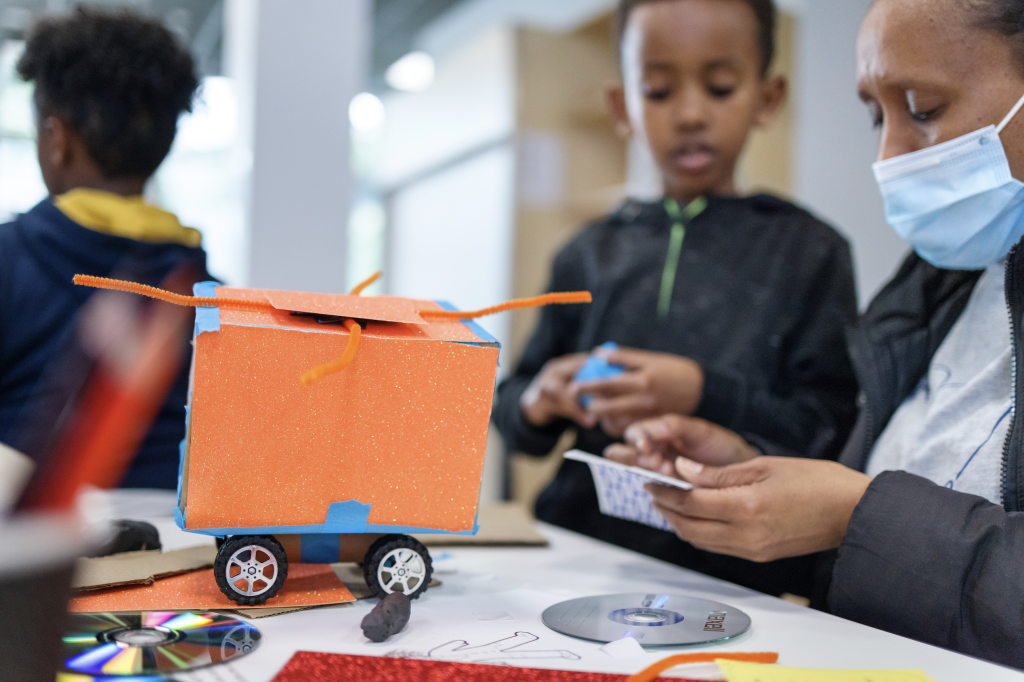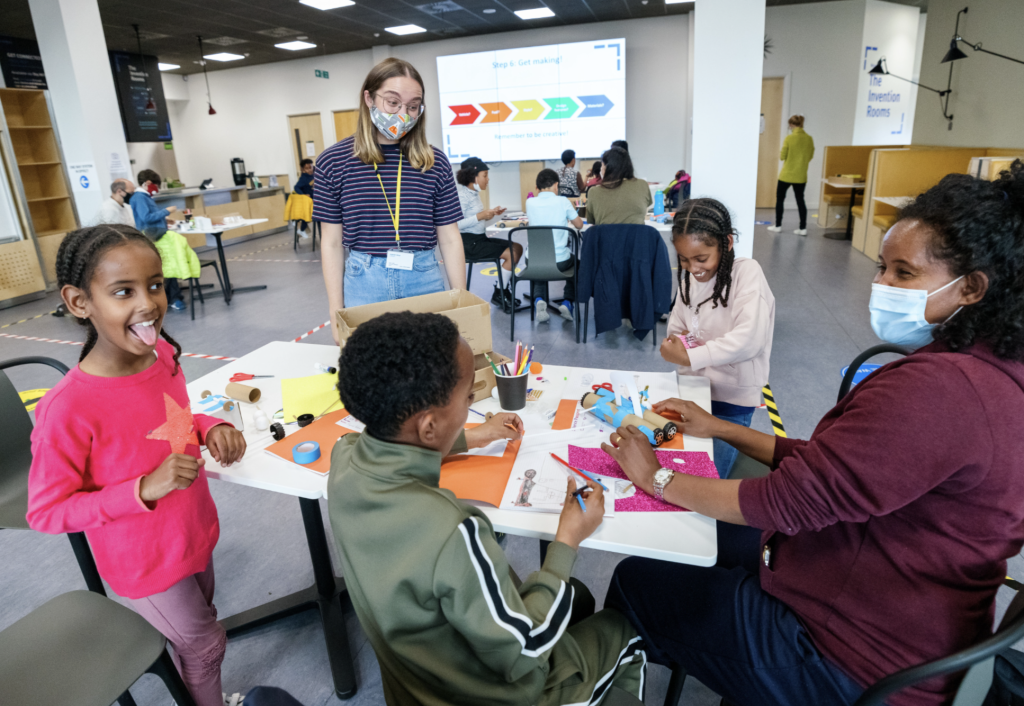For this International Creativity Day (21 April), PhD student Vanessa Madu reflects on the importance of extracurricular STEM clubs in promoting passion for science and mathematics in young students.

“Do ducks have knees?” I earnestly asked Andrew, looking up from the cardboard skateboard ramp we had just finished testing.
He paused for a moment before answering, and what began as a slightly odd question about ducks and their possession of knees became a broader conversation about the bone structure of dogs, bears, humans, and – of course – ducks, as well as other birds. I laughed: “I think this is the only place where we would have this kind of conversation about whether ducks have knees”.
My name is Vanessa Madu, and I am a PhD student in the Modern Statistics and Statistical Machine Learning (StatML) Centre for Doctoral Training at Imperial College London.
My research looks at developing statistical and machine learning models to predict ocean surface currents and my day job does not (typically) allow me to delve into the intricacies of mammalian bone structure.
My rather unusual exchange with Andrew happened at the Saturday Science Club I ran at the White City Invention Rooms, where we welcomed nine families to learn all about complex mathematical systems through fluid dynamical oddities like bottled tornadoes, snail balls, as well as rubber ducks on skateboards that never seemed to land in the same place twice.
We spent two hours learning science on a Saturday, and the children loved it.

One of my favourite questions that we asked the children (and parents) as part of the pre-activity survey was: “How much do you agree: scientists have boring jobs?” The question highlights a problem in the public perception of science that largely stems from how it’s taught.
Despite the increase of students choosing to continue to non-compulsory education in the UK, the number of students electing for STEM subjects has stagnated. All things equal, we’d expect the number of students doing A-Levels and the number of students doing STEM A-Levels to increase in lockstep, but they’re not. This is unusual and is a problem.
To cope and compete in a world that is becoming increasingly digital, technological and automated, students need to be equipped with adequate STEM skills. STEM-related skills like programming, problem-solving, and numerical and statistical literacy are invaluable skill sets for the modern workforce, and equipping students with those skills gives them the best chance at sustained success in a changing world and post-COVID economy.
Mitigating this worrying trend will require work from all fronts – one of the most important takes place in schools and, specifically, in extracurricular STEM clubs.
Re-discovering long-lost love
Science is boring. Well, not exactly. Classroom science is boring, and I would have been the first to admit that. In fact, I’ll let myself from 2015 tell it like it is:
“…believe it or not, I used to hate maths and science with a passion, and a large part of the reason was because it was soooooo BORING!!! But that changed at some point because I got invited to do a whole bunch of cool things.”
– My Adventures at Imperial – September 03, 2015
Albeit with the inflection typical of a 15-year-old, this quote summarised one of the most effective ways to promote positive perceptions of science. I had the opportunity to do “a whole bunch of cool things,” and being able to participate in science in ways that I found interesting was what took me from someone with an active disdain towards learning science to someone who sought (and seeks) out every opportunity to learn that I can.
I started hating maths and science when it became prescriptive, when the emphasis became learning for exams, and when creativity and wonder were discarded as unnecessary. I went to the Ursuline Academy Ilford, an all-girls comprehensive state school that specialised in the sciences. Somehow, despite that specialism, I spent a long time underperforming in science, particularly maths, compared to my potential.
Why? I was bored.
I’d come to school, do variations of the same exercise over and over, and then go home. Why on Earth would I have liked science, or any subject for that matter?
But Mrs Reilly and Ms Russell MBE(!!), my teachers for Design & Technology, spotted more in me than even I knew was there, and I was initiated into what was then a small STEM club. This became my home away from home, and with newfound passions that came with being able to use science and maths in a creative way, my teachers saw a corresponding increase in my performance.
How did saving the bees help save my grades?
For most of my time in the STEM club, I worked on a project to improve inner-city green spaces as a solution to the declining urban bee population. As a group, we aptly and affectionately named the project Beauty and the Bees.
Our plan? To design and create enchanting roof gardens as city green spaces to promote well-being for people and wildlife alike. However, to prove the concept, we needed a model.

We had limited materials to work with, so wasting them was not an option. We calculated the model dimensions that would make the best use of the materials and got to measuring. We had only one chance with some of our materials, so we needed to be sure our numbers were correct. We used mathematical skills like optimisation, measurement, and tiling.
We got mucky, combining aggregate, cement, and sand in the correct proportions, thoroughly mixed by a handy dandy cement mixer (and some elbow grease involving a shovel) to make our model’s concrete base.
But concrete is heavy, and it’s even heavier with a roof garden on top of it, so to make all this effort worth it, we planned how to put our model together so that none of the supports buckled or broke. After all, a roof garden that breaks the roof is not a good roof garden.
Then, of course, a roof garden needs plants, so we experimented to find out which flowers were best for the bees. The chemistry of concrete, physics of structural integrity, and biology of optimal wildflower combinations for urban bees are all science skills!
Finally, we pulled everything together, producing a beautiful result with craftmanship that one can only learn by doing. These are engineering skills!
Working on this project and directly using calculations and concepts that I had learned in the classroom made science interesting and helped me see why it was something worth doing and, therefore, worth learning. Once I saw the point of the STEM subjects I studied, my academic performance in them improved accordingly.
We need more STEM clubs
But this club taught me more than just science! At the tender age of 13, I was learning skills in time management, leadership, organisation, feedback, technical writing, presentation, public speaking, and teamwork. These, too, are STEM skills, but more than that, they are life skills.
The STEM club gave me the opportunity to get invited to “go and do cool stuff” and see that maybe science was for me and perhaps I could go on to achieve and be successful. It helped me learn how to interact with others, something I found difficult, and gave me a place to express the unique person I am in a healthy and constructive way.
Because of how much the STEM club influenced my perception and enjoyment of science, it’s extremely important to me that I bring my research to schools, sharing through outreach science clubs, webinars, and, of course, Saturday Science Club.
I think everyone who wants to be a scientist should have the opportunity to be a scientist.

If it means that I need to have a ridiculously packed schedule so that a Year 5 student tells me that they “look forward to more fun science” at the end of science club or that “the games are fun even though they’re maths” at a primary maths transition program, or that they think my “job is interesting” after hearing me describe what a mathematical ocean scientist does at the Royal Institution, then that is infinitely worth it.
And in case you were wondering, yes, ducks do, in fact, have knees.